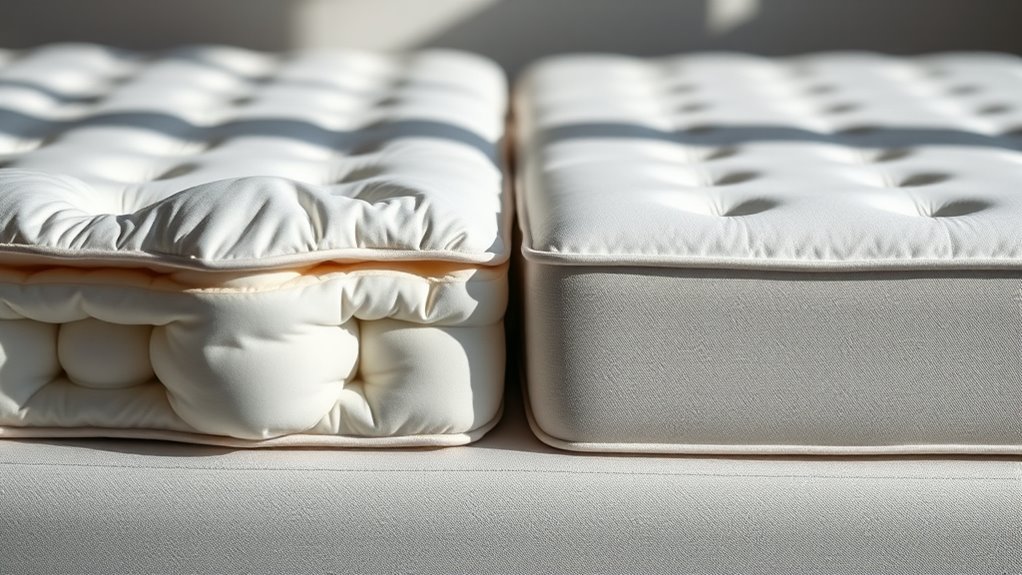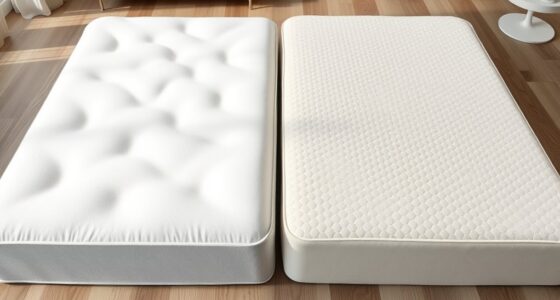Your mattress thickness greatly affects your comfort and support. Thicker mattresses typically provide better pressure relief, contouring to your body and reducing aches, while thinner ones might lack support, causing misalignment. The right thickness helps keep your spine in a natural position and matches your sleep position, whether you’re a side, back, or stomach sleeper. Understanding how each factor works together guarantees you pick the ideal mattress—stay with us to explore more.
Key Takeaways
- Thicker mattresses offer better support through multiple layers that evenly distribute weight and reduce pressure points.
- Proper thickness maintains spinal alignment, preventing sagging or arching that can disrupt sleep quality.
- Layer composition and height influence responsiveness, contouring, and pressure relief for individual comfort needs.
- Thinner mattresses may lack adequate support, leading to misalignment and discomfort, especially for heavier sleepers.
- Suitable thickness varies by sleep position, with side sleepers benefiting from thicker mattresses for shoulder and hip cushioning.
The Basics of Mattress Thickness
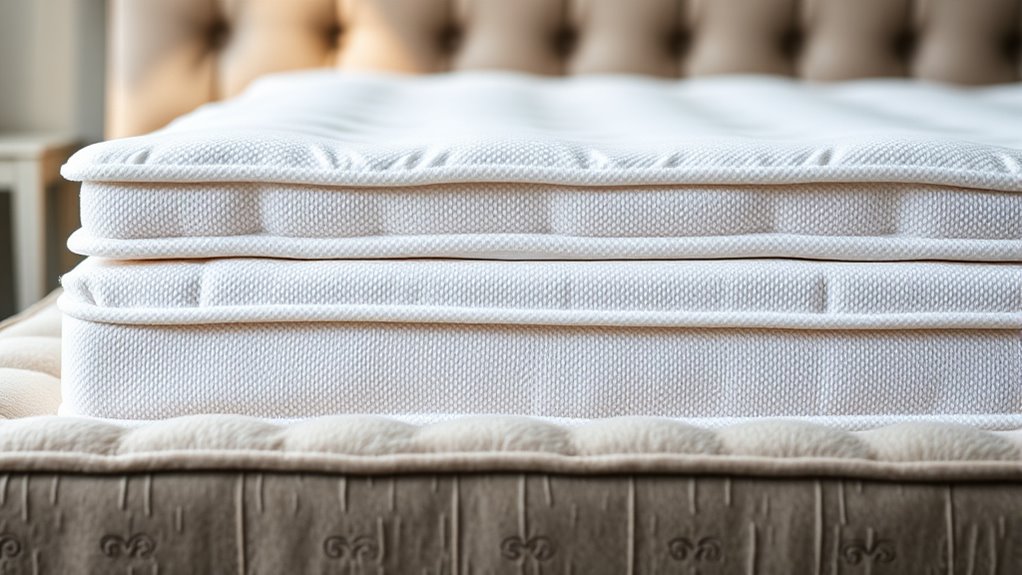
Understanding mattress thickness is essential because it directly affects comfort and support. When considering memory foam mattresses or mattress toppers, thickness plays a key role in how well they contour to your body. Thicker memory foam provides more cushioning, which can enhance pressure relief, making it ideal for those seeking a plush feel. Mattress toppers come in various thicknesses, allowing you to customize firmness or softness without replacing your entire mattress. Thinner toppers add minimal height but can offer a slight comfort boost, while considerably thicker options significantly change your sleeping surface. Knowing how thickness influences feel helps you choose the right layer for your preferences, ensuring a supportive and comfortable sleep experience tailored to your needs. Choosing the right mattress thickness can also improve overall sleep quality and reduce discomfort.
Common Thickness Ranges and Their Features
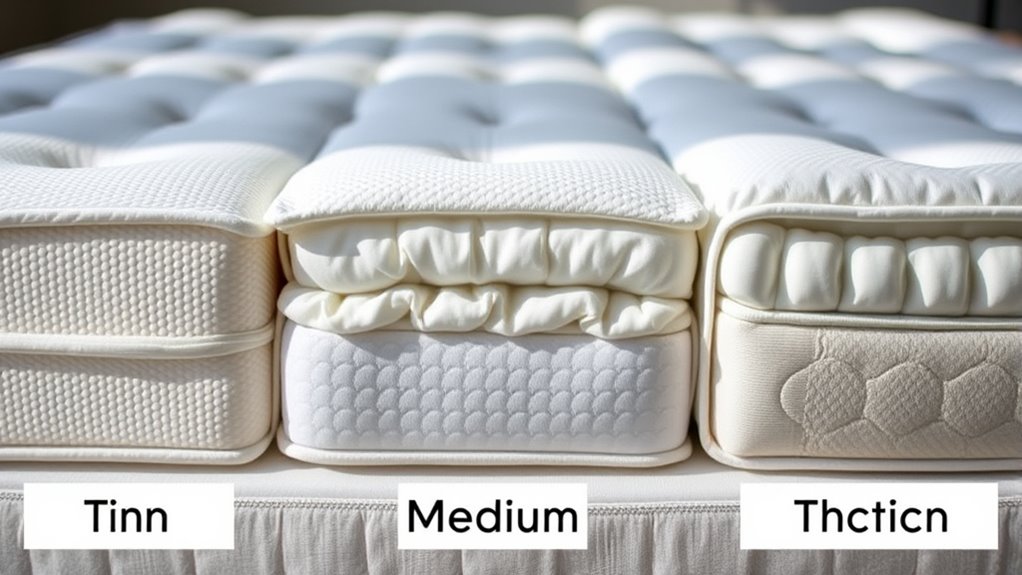
Mattress thickness varies widely, with standard ranges typically falling between 8 to 14 inches. Thicker mattresses often provide extra cushioning and support, while thinner ones can be more breathable and easier to move. Understanding specialized layers helps you choose the right thickness for your comfort and sleep needs.
Standard Thickness Variations
Standard mattress thicknesses typically fall within a few common ranges, each offering distinct advantages. Thin mattresses, around 6 to 8 inches, are lightweight and easy to move but may lack enough support for heavier sleepers. Medium thicknesses, 10 to 12 inches, are versatile and provide a good balance of comfort and support, often suitable for most sleep styles. Thicker mattresses, 14 inches or more, tend to feature multiple layers of memory foam or breathable materials, enhancing contouring and airflow. Memory foam layers in thicker beds offer personalized support, while breathable materials help regulate temperature. Additionally, Glycolic Acid benefits are most effective when incorporated into routines with consistent use, which can also influence how you select your mattress support. Keep in mind that thickness influences comfort, support, and ease of movement, so choosing the right range depends on your specific needs and preferences.
Thick vs. Thin Benefits
Thick and thin mattresses each offer unique benefits that cater to different sleep needs. Thicker mattresses, often over 12 inches, provide enhanced support and better pressure relief, especially with memory foam layers that contour your body. They’re ideal if you want a plush feel or need extra cushioning for joint pain. On the other hand, thinner mattresses, around 8-10 inches, tend to be more lightweight and easier to move. They often use eco-friendly materials like natural latex or recycled fibers, making them a sustainable choice. Thin mattresses also promote better airflow and temperature regulation, which benefits hot sleepers. Your choice depends on your comfort preferences, support needs, and eco-conscious priorities. Both thickness ranges serve specific purposes, ensuring you find a mattress that suits your sleep style. Additionally, the bedroom environment can influence how a mattress feels and performs, making it an important factor to consider when selecting the right thickness.
Specialized Mattress Layers
Specialized layers within mattresses vary considerably based on their thickness, each designed to target specific comfort and support needs. Memory foam layers, often ranging from 1 to 4 inches, contour closely to your body, offering personalized pressure relief. Thicker memory foam layers provide enhanced support and cushioning, ideal for pressure point reduction. Cooling technology layers, typically 1 to 2 inches, are integrated to improve airflow and regulate temperature. These layers help prevent overheating during sleep, especially in warmer climates or for those who tend to sleep hot. Combining these layers allows for a more customized sleep experience, balancing support, comfort, and temperature regulation. Ultimately, the thickness of specialized layers influences how well your mattress responds to your body and preferences. Additionally, Honda Tuning principles, such as optimizing performance and comfort, can be applied to select the right combination of layers for personalized sleep quality.
How Thickness Affects Pressure Relief
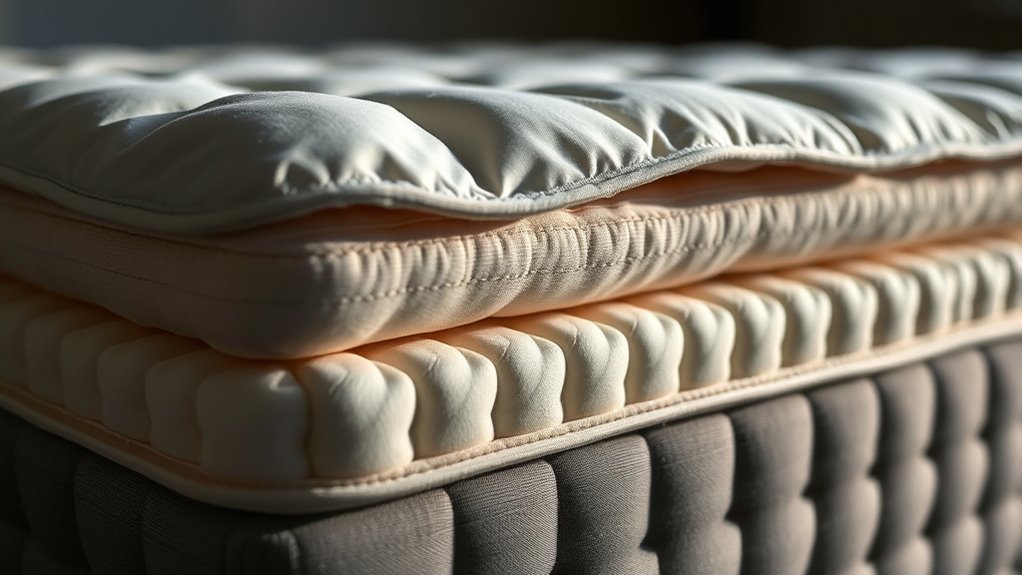
Thicker mattresses often provide better pressure distribution, helping you feel more supported in sensitive areas. The firmness level also influences how thickness impacts pressure relief, with softer options offering more cushioning. Additionally, the layer composition plays a key role, as different materials can enhance or reduce how effectively pressure is alleviated. Incorporating pressure-relief features such as specialized foam layers can further improve comfort and support.
Enhanced Pressure Distribution
Since mattress thickness directly influences how pressure is distributed across your body, selecting the right thickness can considerably enhance comfort. Thicker mattresses better contour to your shape, offering enhanced pressure relief and reducing discomfort in sensitive areas like shoulders and hips. This improved pressure distribution creates a more balanced sleep environment, supporting overall sleep quality. Additionally, the right thickness can help maintain bedroom aesthetics by providing a sleek, uniform look. Keep in mind, thicker mattresses may require more frequent mattress maintenance to prevent sagging and ensure long-term support. For optimal pressure distribution, choosing the appropriate mattress thickness is essential. Here’s how different thicknesses impact pressure distribution:
| Mattress Thickness | Pressure Relief | Maintenance Needs |
|---|---|---|
| Thin (6-8 inches) | Moderate | Low |
| Medium (10-12 inches) | Good | Moderate |
| Thick (14+ inches) | Excellent | Higher |
Impact of Firmness Levels
While mattress thickness plays a significant role in pressure distribution, the firmness level of the mattress also critically influences how pressure is alleviated across your body. A firmer mattress provides more support, which can help maintain proper spinal alignment and reduce pressure points, leading to a more restful sleep cycle. Conversely, a softer mattress contours to your body, easing pressure on sensitive areas but potentially sacrificing support. The right firmness level enhances mattress durability by preventing sagging and indentations, ensuring consistent pressure relief over time. Your choice impacts not just immediate comfort but also how well your body recovers overnight. Striking a balance between firmness and thickness ensures ideal pressure relief, supporting both your sleep quality and the longevity of your mattress. Additionally, understanding inspirational quotes about fatherhood can remind you of the importance of support and comfort in all aspects of life, including sleep.
Role of Layer Composition
Have you ever wondered how the composition of mattress layers influences pressure relief? The key lies in layer diversity and the material blend used. A well-designed mattress combines different materials to target specific pressure points, offering better support and comfort. For example, memory foam molds to your body, reducing pressure, while latex provides responsiveness and durability. The right material blend creates a balanced layer composition that disperses weight evenly, preventing discomfort. Thicker mattresses often incorporate multiple layers with varied densities, enhancing pressure relief across different zones. Additionally, understanding the fundamentals of personal development can help you make more mindful choices about your sleep environment. By choosing a mattress with thoughtful layer diversity, you guarantee ideal support and comfort tailored to your body’s needs, making each night’s sleep more restful and restorative.
Support Levels in Different Mattress Heights
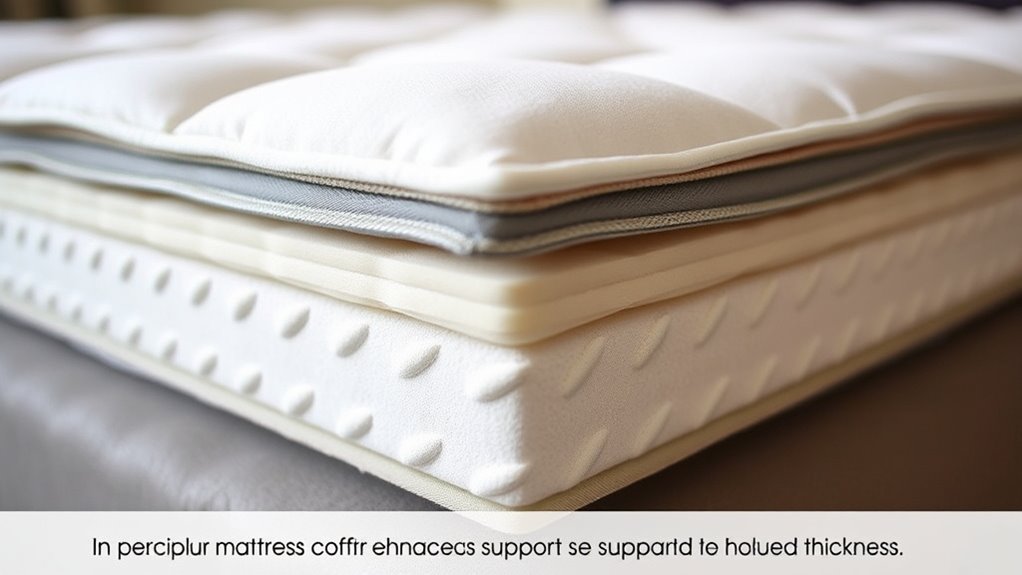
The height of a mattress considerably influences its support levels, affecting how well it cradles your body and maintains proper spinal alignment. Thicker mattresses generally offer enhanced support because they can incorporate more layers designed to distribute weight evenly. A taller mattress can also improve your sleep environment by providing better pressure relief and reducing motion transfer. Additionally, cookie preferences can impact your overall experience and customization options. However, support isn’t just about height; pillow firmness plays a role too, as it complements your mattress in maintaining proper alignment. If your mattress is too thin, you may feel less supported and more pressure points, which can lead to discomfort. Conversely, very tall mattresses might feel overwhelming or difficult to get in and out of bed. Optimal support depends on finding the right balance between height, firmness, and overall construction.
Impact of Thickness on Spine Alignment
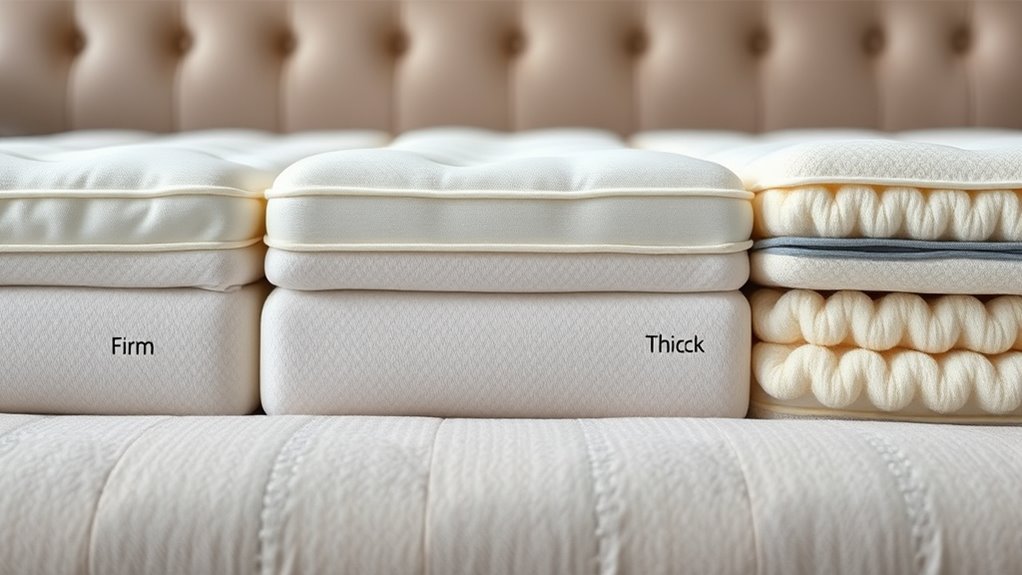
Your mattress thickness plays a key role in keeping your spine properly aligned while you sleep. Variations in thickness can affect how well your body is supported, especially in different sleep positions. Understanding this impact helps you choose a mattress that promotes better posture and comfort throughout the night.
Spinal Alignment Preservation
Choosing the right mattress thickness directly influences how well your spine stays aligned during sleep. A thickness that’s too soft or too firm can cause your spine to sag or arch unnaturally, disrupting your sleep hygiene. Luxury bedding often features mattresses designed to provide ideal support, ensuring your spine remains in a neutral position throughout the night. When your mattress offers proper thickness, you maintain better spinal alignment, reducing pressure points and minimizing discomfort. This not only supports healthy posture but also helps prevent long-term back issues. Additionally, remote hackathons provide opportunities for collaboration and innovation outside traditional environments, which can inspire new ideas for sleep technology. By selecting a mattress with the right thickness, you create an environment that promotes restful sleep and preserves the natural curvature of your spine, contributing to overall comfort and well-being.
Effects of Thickness Variations
Variations in mattress thickness can considerably impact how well your spine stays aligned during sleep. Thinner mattresses might not offer enough support, causing your hips or shoulders to sink too much and misalign your spine. Conversely, thicker mattresses can provide more contouring, especially with memory foam layers that adapt to your body’s shape. Adding cooling gels to thicker mattresses helps regulate heat and maintain comfort, preventing overheating that could disrupt alignment. If your mattress is too thin, it may lack the necessary material to cushion pressure points, leading to discomfort and poor spine positioning. On the other hand, excessively thick mattresses may cause your body to sink excessively, disrupting natural posture. Striking the right balance in thickness ensures your spine remains properly aligned, supporting restful, healthy sleep. Understanding mattress safety is also crucial for ensuring your mattress supports healthy sleep habits and reduces potential health risks.
Support for Different Sleep Positions
The thickness of a mattress considerably influences how well it supports different sleep positions, especially regarding spine alignment. A thicker mattress can provide better support for side sleepers by filling in the space between your shoulder and waist, promoting proper spinal alignment. For back sleepers, medium-thick mattresses help maintain a neutral spine, reducing strain. Stomach sleepers might prefer slightly firmer, thinner options to prevent sinking too deeply. Your pillow preferences also matter—adding a supportive pillow can enhance spinal alignment regardless of mattress thickness. Bedding accessories like contour pillows or mattress toppers can further customize support for your specific sleep position. Additionally, understanding the importance of proper support can guide you in selecting the ideal mattress thickness for a comfortable and healthy sleep posture. Ultimately, choosing the right mattress thickness helps keep your spine aligned, minimizing discomfort and supporting restful sleep.
The Relationship Between Thickness and Motion Isolation

Thicker mattresses generally excel at reducing motion transfer because they provide more material to absorb and dampen movements. Memory foam layers in thicker mattresses are especially effective at isolating motion, preventing disturbances from transferring across the bed. This makes them ideal if you share a bed and want minimal disturbance when your partner moves. Additionally, a thicker mattress can improve edge support, which helps keep you centered and reduces the feeling of movement near the edges. However, keep in mind that increased thickness can sometimes make it harder to move or get in and out of bed, but for motion isolation purposes, the added material works to your advantage. Vetted materials in mattress construction contribute to better durability and support, further enhancing sleep quality. Overall, greater thickness enhances your sleep quality by minimizing disruptions caused by movement.
Suitability of Various Thicknesses for Different Sleep Positions

Choosing the right mattress thickness depends heavily on your sleep position, as different postures place varying demands on support and comfort. For side sleepers, a thicker mattress (around 12 inches) works well, as it cushions shoulders and hips; pairing it with softer pillow types enhances pressure relief. Back sleepers benefit from medium-thickness mattresses (10-12 inches), which provide balanced support for spinal alignment, especially if you use firmer pillows. Stomach sleepers often prefer thinner mattresses (8-10 inches) to prevent excessive sinking, combined with firmer pillows to keep the neck aligned. Bedding materials also matter—memory foam or latex molds well to different thicknesses, offering tailored support. Additionally, understanding how personal finance management can influence your ability to invest in quality bedding can help you make more informed decisions. Choosing the right combination ensures your sleep position is supported comfortably without compromising support or pressure relief.
Factors to Consider When Choosing Mattress Thickness
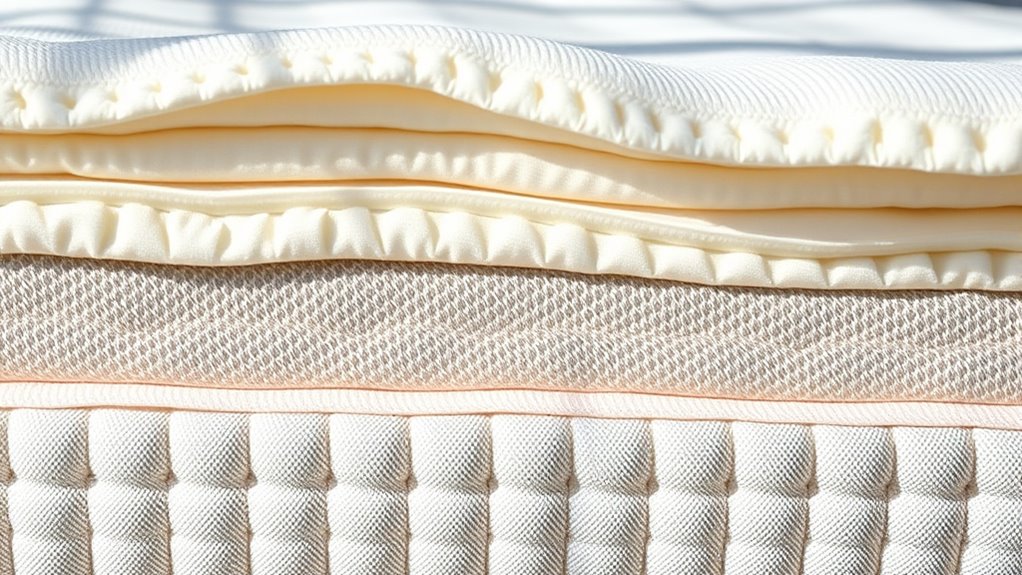
When selecting a mattress thickness, it’s important to take into account your personal sleep habits and specific comfort needs. Consider how the thickness affects mattress aesthetics; a thicker mattress can create a plush, luxurious look, while a thinner one offers a sleeker appearance. Additionally, think about mattress durability—thicker mattresses often use more layers and materials, which can enhance longevity but might also add weight. Your preferred sleeping position and any health concerns should influence your choice, as thicker mattresses may better support side sleepers or those with joint issues. Balance these factors with your aesthetic preferences and durability expectations to find the right thickness that offers both comfort and lasting support. Water parks often feature slides, lazy rivers, and splash zones that require safe and supportive surfaces, highlighting the importance of choosing a mattress thickness that offers proper support for restful sleep.
Potential Drawbacks of Very Thick or Thin Mattresses
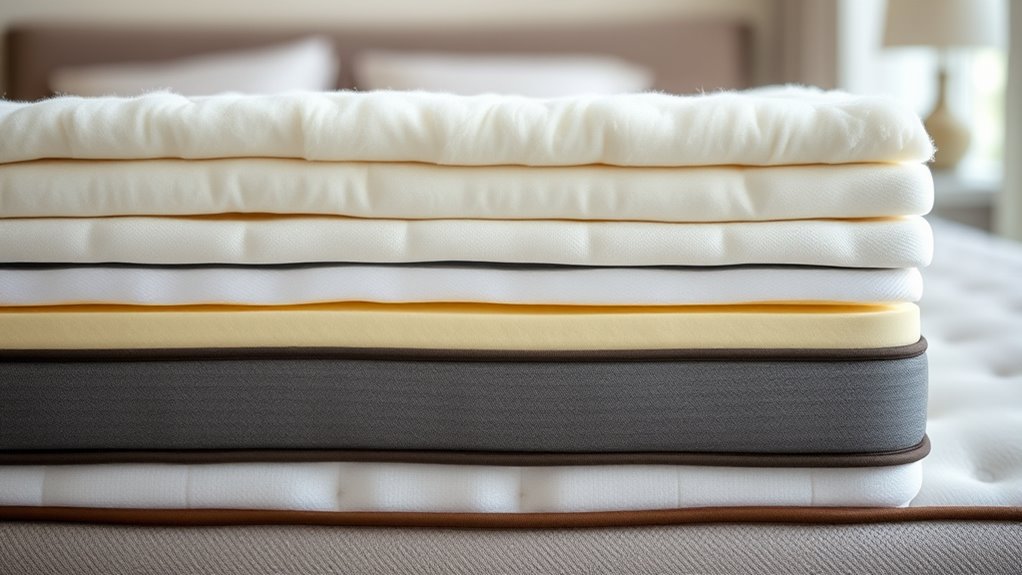
While very thick or thin mattresses might seem like good options at first glance, they can present notable drawbacks. Extremely thick mattresses may not fit standard bed frames, leading to compatibility issues, and you might need a new frame or special supports. They can also be harder to move, lift, and store, which complicates maintenance or relocation. On the other hand, very thin mattresses might lack sufficient support, causing discomfort and potentially worsening back pain. Additionally, thin mattresses may not be compatible with certain bed frames, especially those designed for deeper mattresses, making setup tricky. Both extremes can limit your options, increase costs, and create inconvenience. Carefully consider how thickness affects both your bed’s compatibility and your storage needs before making a decision.
Tips for Testing and Selecting the Ideal Mattress Thickness
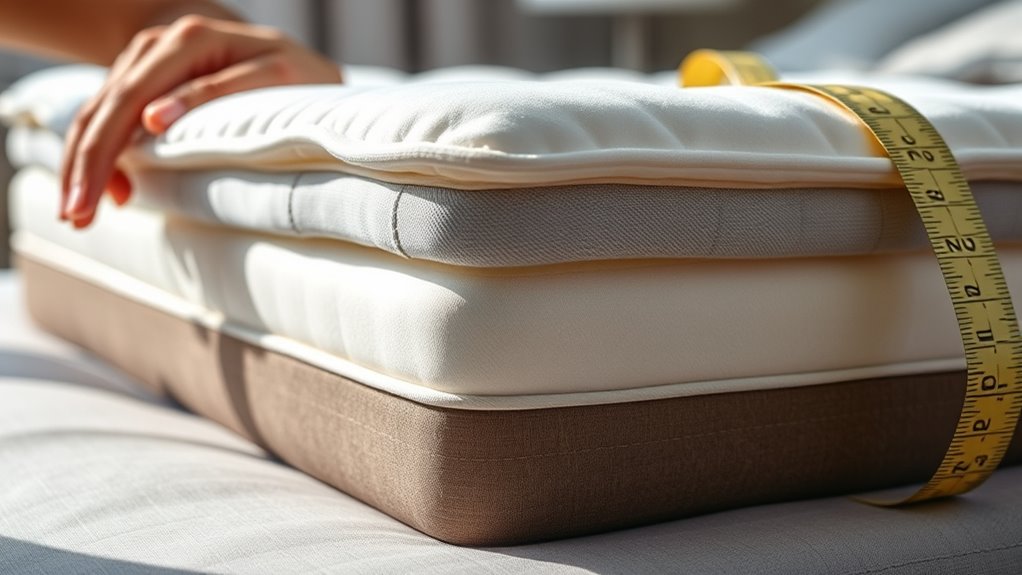
To find the ideal mattress thickness for your comfort and support, start by testing different options in person. Lie down on mattresses of varying thicknesses to see how they feel under your body. Pay attention to your pillow preferences, as your pillow height can influence how supportive a mattress feels. Consider your bedding accessories, like mattress toppers or sheets, which can alter overall comfort. While testing, notice how well the mattress supports your hips, shoulders, and back, ensuring proper spinal alignment. Take your time and switch positions to evaluate pressure points and overall feel. Remember, what works for someone else might not suit you, so trust your comfort instincts. This hands-on approach helps you choose a mattress thickness that suits your unique needs.
Frequently Asked Questions
How Does Mattress Thickness Influence Overall Durability and Longevity?
You’ll notice that thicker mattresses often last longer because they use higher foam density, which resists sagging and wear. Plus, extra thickness usually means better edge support, preventing mattress breakdown at the edges. This improved durability means your mattress maintains its shape and support over time, giving you a better investment. So, when choosing a mattress, consider thickness to guarantee it’s durable enough to provide lasting comfort.
Can Mattress Thickness Affect Temperature Regulation During Sleep?
Think of your mattress like a cozy blanket—thicker options can trap heat, affecting breathability concerns. If it’s too thick, thermal insulation might cause you to overheat, making it hard to stay cool. Conversely, a thinner mattress allows better airflow, promoting breathability during sleep. So, your choice of thickness directly impacts temperature regulation, ensuring you stay comfortable and cool all night long.
Is Thicker Always Better for Heavier Sleepers?
Thicker mattresses aren’t always better if you’re a heavier sleeper. Your weight distribution matters, and a thicker mattress can provide better pressure relief by supporting your body evenly. However, if it’s too thick, it might cause you to sink too much or feel unstable. Ultimately, choose a mattress that balances thickness with proper support, ensuring your weight is well distributed for comfort and effective pressure relief during sleep.
How Does Mattress Thickness Impact Ease of Movement and Shifting Positions?
Mattress thickness can influence your movement ease and position shifting. Thicker mattresses often provide more cushioning, allowing you to move more smoothly and change positions without feeling stuck. However, very thick mattresses might make it harder to get in and out of bed. You’ll find a balanced thickness offers better support for shifting positions comfortably, helping you stay relaxed and undisturbed throughout the night.
Are Certain Mattress Thicknesses More Suitable for Specific Body Types?
Choosing the right mattress thickness feels like finding your perfect dance partner. Thinner mattresses, around 8-10 inches, suit those with a leaner body type or who sleep on their stomach, offering better support. Thicker options, 12 inches or more, are ideal for heavier body types or side sleepers, providing extra cushioning. Match your body type and sleeping position to a mattress thickness that keeps you comfortable and well-supported all night.
Conclusion
Choosing the right mattress thickness can feel like finding the Holy Grail of sleep—transforming nights from restless chaos to cloud-like bliss. Don’t settle for a mattress that’s too thin and leaves you tossing like a fish out of water, or one that’s so thick you need a ladder to get in bed. Trust your comfort instincts, test different options, and find that perfect thickness that makes waking up a joy, not a chore. Sleep tight, superstar!
